2017 Hybrid Go-Kart – Team 2
About the Project
The Hybrid Go-Kart senior capstone project will incorporate the Mechanical Engineering Technology (MET) and Electrical Engineering Technology (EET) programs in order to complete the first dual major capstone of its kind at the University of Maine. Our client has requested of us to create a chassis that can be used to test a hybrid-vehicle prototype. The battery-less hybrid prototype system will be handled by the EET team, we will be designing the kart chassis to include the internal combustion engine powering the generation system and drive from the electric motor. The grand scheme of this project is to make a light-weight hybrid battery-less vehicle that achieves normal operating characteristics as that of a standard gasoline powered car. The chassis has to be capable of supporting the internal combustion engine, power generation unit, and the electric drive system. It also has to be able to be safely operated with one person on board. The multiple sponsors and point of contact for this project can be viewed at the bottom of this site.
The groups latest Interim report completed on 5/8/17 can be viewed by clicking on the attached link. 
Weekly Update
5/3/2017
- The team presented their capstone on 5/3/17. The goal is to now do testing in order to see if they met their goals of 50 mpg and 50 mpg efficiency. The final product can be seen in Figure 9. The team hopes to make future revisions to the project including reducing weight, improving steering, adding a debris guard under the belt drive and improving overall performance.
Figure 9. Final Product
4/25/2017
- The Go Kart is now nearly complete. The group was able to add a few more mounts for electrical components, create an oil bath for the gear, fabricate a removable floor and hook up the throttle, choke and starter to the dashboard. The Go Kart is currently disassembled for painting.The completion of the steering and minor adjustments are all that stand in the way of completion. Presentation of the final project will be on Wednesday, May 3rd.
4/20/2017
-
The team was able to restore an old salvaged seat to use for their final go kart. The seat was in very rough shape with many old patches as can be seen in Figure 8. With the use of a chop gun combined with a lot of sanding the seat was brought back to life as can be seen in Figure 7. The seat has now been finished and prepped for paint.
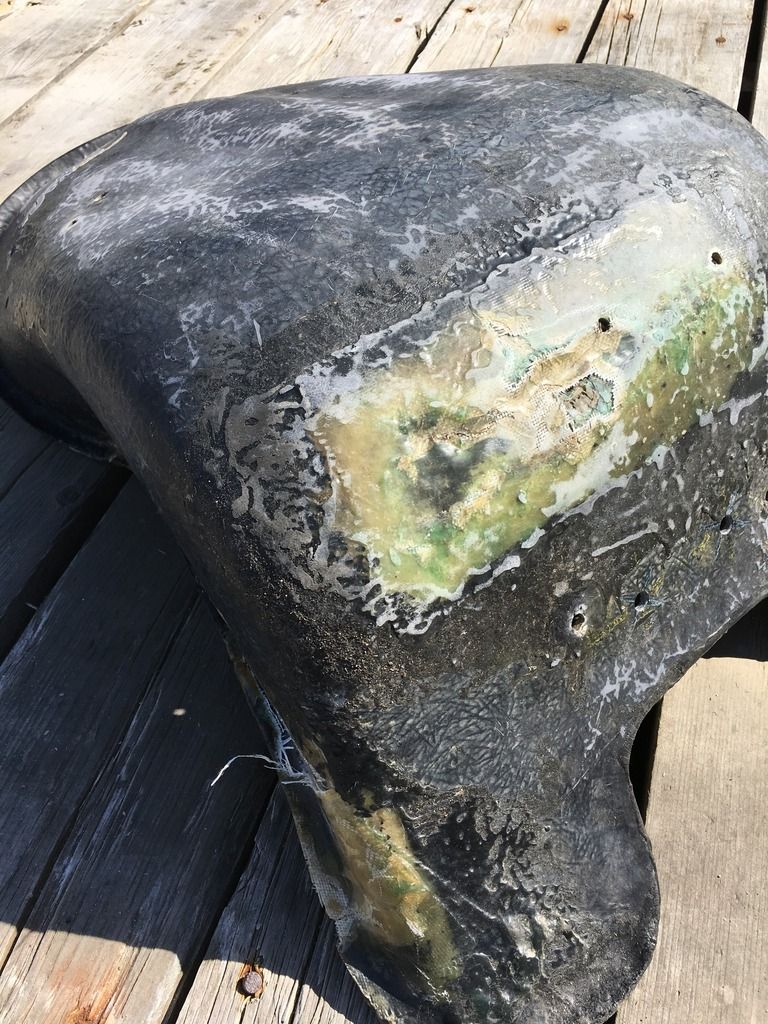
Figure 8. Old Seat
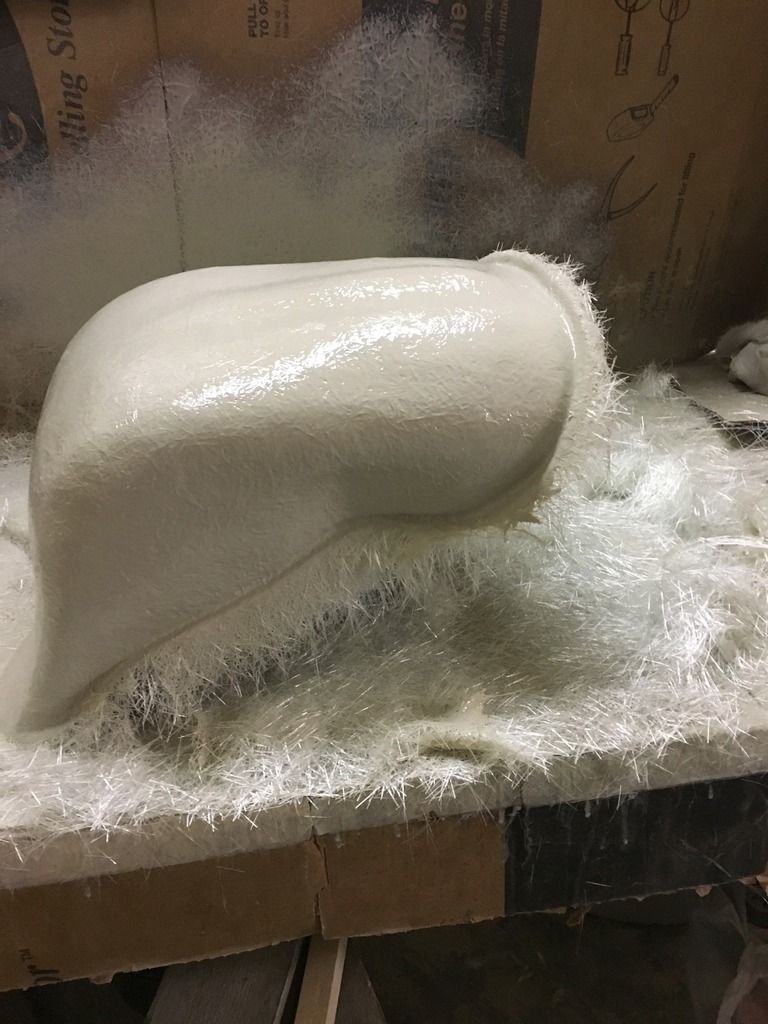
Figure 7. Fiberglassed Seat
4/20/2017
- The team spend much of this week in the machine shop finishing up the steering components. The water jet was used one final time and those components were brought within tolerance. A few small things to be threaded and all machining will be completed. Figure 7 shows a few of the parts that the team has been working on. The team is now working on final assembly, mounting the propane tanks, fabricating a floor and finish welding the chassis.
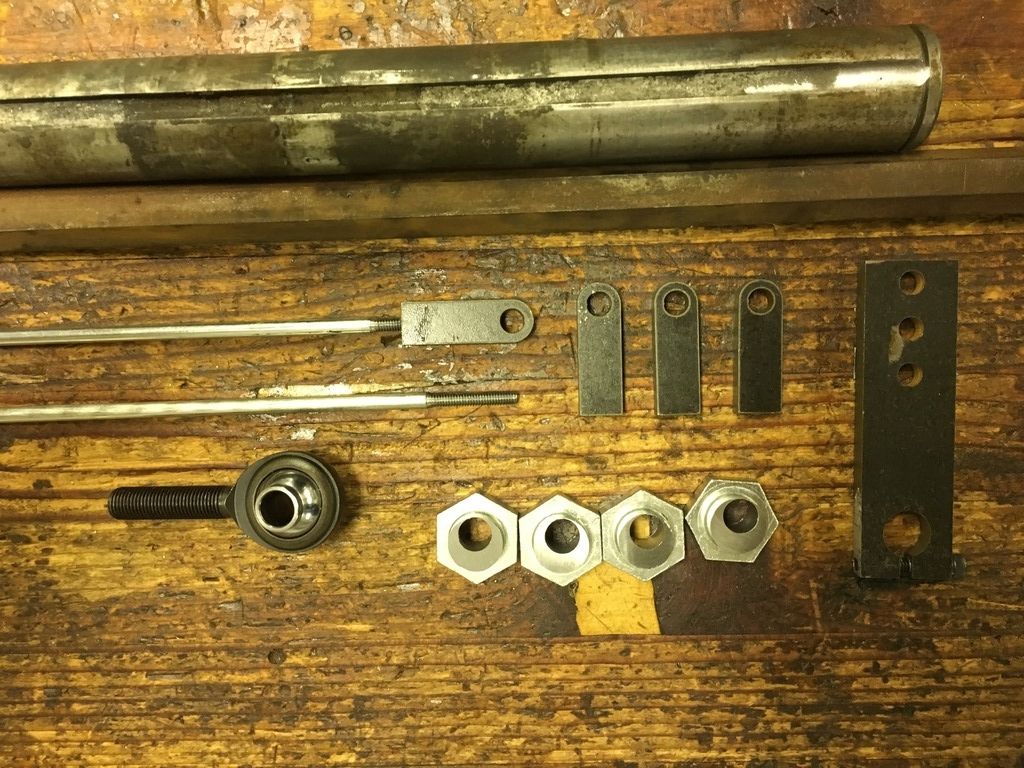
Figure 6. Steering Components
4/12/2017
- The EET team presented the electrical system involved with the kart. The focus has now shifted toward finishing the mechanical side of the kart including steering and minor machine work. Figure 5 shows the alternators mounted on the chassis.The goal is to have the kart complete ahead of schedule in order to make final adjustments and do testing.
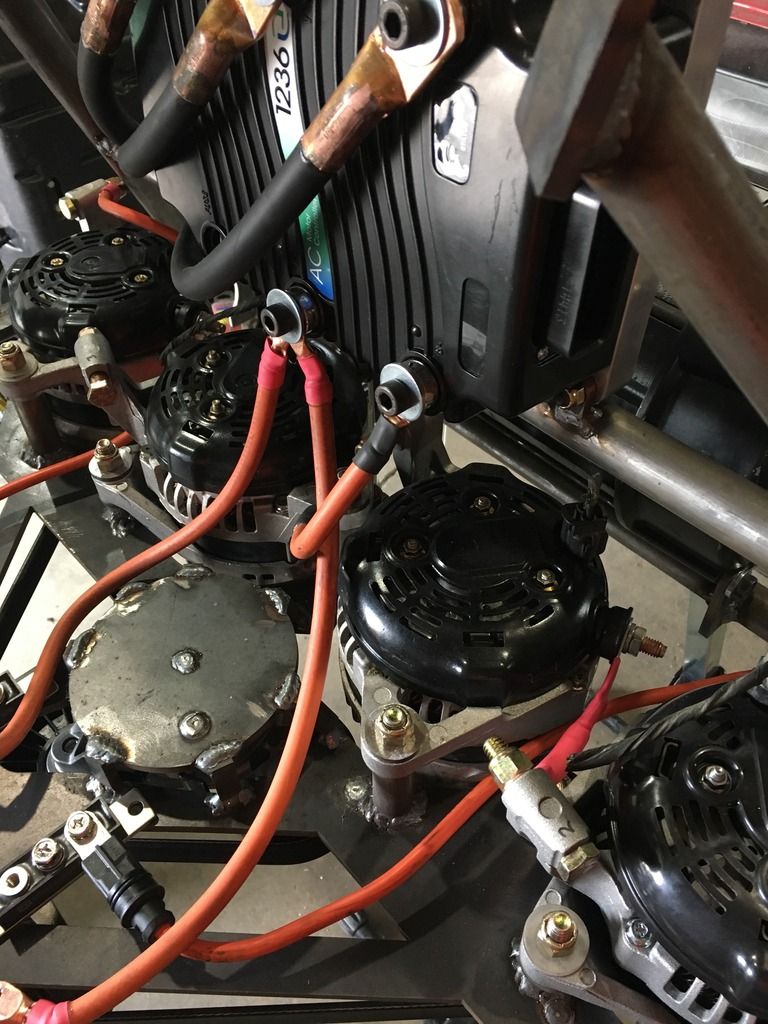
Figure 5. Alternators
4/10/2017
- The group spent a lot of time in the machine shop and continuing to fix problems that were encountered with the kart. With the work done this week the whole drive system is complete and operational. The wiring is nearly done and the capacitor bank is complete. The tension of the drive belt was altered by adding a custom fabricated tensioner in order to get slack in the belt for removal or starting and to then tighten in up with the snap of a lever. The EET team will be doing their finishing touches and then the mechanical side of the project will focus on the steering and axles of the kart.
4/3/2017
- The project made large progress this week. The alternators, belts, motors, and controller were all successfully installed onto the chassis. There were many hiccups but with persistence and a lot of hours the kart is beginning to take shape. The EET side of the project will be presenting on 4/12/17 so the focus is on the electrical side of the project currently.
3/24/2017
- The chassis of the cart was bent in three separate pieces. The three pieces were then welded together and cross members were added to the chassis. The electric motor mount and alternator bracket were then welded into location on the chassis as shown in Figure 4. The team is now focusing on completing the chassis fabrication and incorporating the EET side of the project into the chassis.

Figure 4. Chassis Fabrication
3/13/2017
- Over spring break the project began to come to life. The water jet maintenance was complete and many of the components were able to be cut. The team then had to spend a lot of time in the machine tool shop getting all holes and dimensions to the correct tolerances. The bender was used to start creating the chassis as seen below in Figure 3.

Figure 3. Chassis Practice Bends
3/1/2017
- The group focus this week turned toward their Interim report 3. The group was able to get all bushing and plates complete in solid edge and now have all needed components in CAD.
2/20/2017
- The water jet was down for maintenance so the cutting of the components has been pushed back until next week. The chassis and steel tube came in so the chassis is ready for manufacturing. A few sponsors agreed to help fund the project. The group is very pleased with the current position of the project and hopes to do much of their manufacturing of the cart over spring break.
2/13/2017
- This weeks progress was slowed down due to many snow days but the two motor mount components and the alternator bracket were both sent in to be cut out of 1/4″ steel using a water jet.
2/6/2017
- This week three more sponsors were added to the project. The propane motor mount design was finalized so that the engine plate will be removable but the actual mounts will be welded into the frame. These mounts will have slots so the belt can be tightened to full length before securing the motor plate down. As soon as these two components are machined photos of the finished product will be uploaded to this site.
1/30/2017
- A chassis design was created using Solidworks with emphasis on being sure all components will fit properly. The chassis will be flat with the rear axle placed under the frame in order to increase the clearance for the belt drive. The major driving dimensions of the design are that the axle brackets will be 32″ wide at both the front and rear of the cart. There must also be adequate room in front of the forward wheels for the propane motor and also room behind the seat for the electrical components. The chassis design is estimated at 75% complete. The goals for this week are to continue working on the alternator drive, overall layout of components and finalize the chassis design.
1/23/2017
- Over the winter break a few more sponsors came on board to help fund this project. A new weekly meeting time was set for the group and the major short term goals are to finalize the chassis design and edit out small details in the belt drive system.
12/7/2016
- For the last meeting before winter break the group assigned each member small tasks to work on and set the goal of starting manufacturing as soon as we all return next semester. Ahmad will be working on the chassis design and updating his analysis of the chassis. Stacy will continue being in contact with potential sponsors and working on acquiring a pipe bender for the chassis. Tim will make sure the bracket design will work correctly with the chassis and will be exploring the possibility of renting a water jet. Merritt is responsible for updating this existing website and adding the contributing sponsors to our acknowledgments section. We plan on meeting the first week of next semester to set up our weekly group meeting time and also discuss the overall plan for the semester.
11/30/2016
- The group returned from thanksgiving break with the motor mount bracketry and alternator mount bracketry designs both finalized. The group began analysis in order to better understand the chassis design needs. Due to the large amount of weight being placed on the front and rear of the cart the group needed to try to keep the cart as balanced as possible. The weights of each component are listed in Table 1 and the weight distribution graph is located in Figure 2. Although a weight ratio of 50:50 would be ideal, we currently have about a 34:66 weight ratio (front:back).
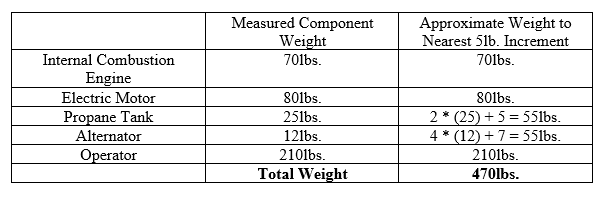
Table 1. Component Weights
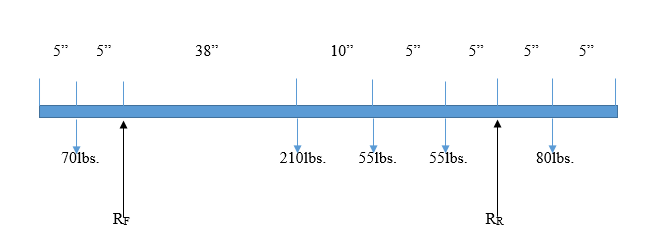
Figure 2. Cart Weight Distribution
.
11/23/2016
- This week the group outlined their plans for the rest of the semester and the goals that need to be met by then. The group intends to have both the motor mount and alternator mount designs complete in order to begin production and testing of the electrical side of the project. The intern report #2 will need to be completed prior to 12/7/16 and the team will need to plan on meeting for this. Talking with sponsors and testing and of potential chassis designs are also important matters to discus after thanksgiving break.
11/16/2016
- The group met and dismantled the donor go kart. The total predicted dimensions of our chassis design currently stand at 58″ x 32″ between axle mounts. It was found that the motor should be mounted sideways on the chassis in order to create the needed room for steering components. The motor will be slightly offset in order to center its weight on the chassis. The rear axle will be placed below the cart in order to make clearance under the cart for the belt to run from the front motor shaft to the alternators in the rear. The go kart components are all currently selected and chassis design is in progress. The current lay out for the go kart is located in Figure 1 below.
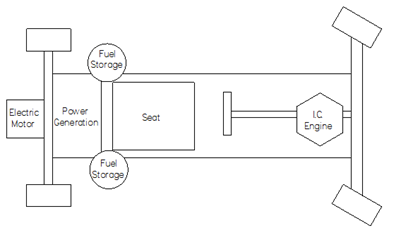
Figure 1 Go-Kart Layout
11/9/2016
- Planning for the rest of the semester was done during this weeks meeting. The group hopes to have the two mounts finalized by next week. The group went over the two mounting ideas and critiqued them for further revision. The hole dimensions on the alternators and motor where measured and recorded to be able to add these holes to the mounting designs. We will meet next week to dissemble a donated parts go kart in order to get a better idea of chassis dimensions including steering angles, front to rear axle length and total width. These will be the key measurements as the rest can be adjusted as more room is needed for hybrid components.
11/2/2016
- We continued working with possible sponsors about gaining funding. A first draft of the motor mount and alternator mounts were designed. This mounts are made completely separate of the chassis in order to be removed for bench top testing. The EET side of the project will use these mounts in order to get the electrical side of the project set up and adjusted properly. The two mounts will be flat 1/4″ plates that will be clamped to the chassis using a machined clamp that will bound the whole 1″ tubing being used for the chassis.
10/26/2016
- The intern report was finalized and a gantt chart was established detailing the timeline for our project. The budget and inventory were all accounted for this week to see where we need to go from this point. As the project stands now the budget will be roughly $2,000 pending sponsor contributions. A goal was set to have the final product of this go-kart reach a speed of 50 mph with a propane fuel efficiency equivalent of 50 mpg. This week Tim will look deeper into the generation aspect of the design well Stacy focuses on the belt tension design around the idlers and alternators. Merritt and Ahmad will work together on the chassis design, motor plate mount and overall layout.
10/19/2016
- The team took this week to focus more on the work required for their intern report. The members each took time doing research required in their report. Ahmad was responsible for the research of standards in vehicles such as commissions. Merritt researched the current standards of hybrids while Stacy focused on current hybrid designs and the most up to date features and ideas. Tim will be busy putting all of this together into one elaborate report to demonstrate our progress on this project.
10/12/2016
- This week each team member took a separate roll in research toward the cart. Stacey is the link between the EET and MET side of the project and worked with both groups trying to get both teams on the same page. The major points of each design were discussed. Tim focused on the drive of the propane engine and how the belt will create energy through the alternators. Ahmad and Merritt both researched information pertaining to the frame. Ahmad concentrated more on the pipe sizing while Merritt focused more on the cart design.
10/5/2016
- The group each researched different hybrid vehicle options and which would be most feasible to adapt toward a go-kart. This research was discussed and we decided to go with a hybrid option that consists of a propane combustion engine running a belt over alternators that will in turn power the electric motor that will run the cart.
Team Bios
Timothy Degnan
 Tim is a 21 year old MET Major from Charlton, Massachusetts. During his time at the University of Maine he has become a part of Alpha Gamma Rho, UMaine Fishing Club and the UMaine Car Club. Tim currently works at the UMaine advanced structures and composites center doing materials testing and manufacturing. His previous work experience includes installing solar panels with Sun Run Solar on residential homes throughout the state of Massachusetts, building a project motorcycle (1981 cx500c Honda that he’s making a cafe racer) and building his own room at his fraternity house. During the course of his enrollment he has learned that you cannot overlook anything during a test, safety is the number one priority and that a project leader must understand the strengths and weaknesses of the team and push people out of their comfort zone in order to help them learn. The reason that Tim chose MET as a major was because he wanted the hands on learning experience coupled with the manufacturing based learning. Upon completion of the program Tim would love to get a job in a manufacturing position and has applied to the composites center for a full time position there being a wood composites technician.
Tim is a 21 year old MET Major from Charlton, Massachusetts. During his time at the University of Maine he has become a part of Alpha Gamma Rho, UMaine Fishing Club and the UMaine Car Club. Tim currently works at the UMaine advanced structures and composites center doing materials testing and manufacturing. His previous work experience includes installing solar panels with Sun Run Solar on residential homes throughout the state of Massachusetts, building a project motorcycle (1981 cx500c Honda that he’s making a cafe racer) and building his own room at his fraternity house. During the course of his enrollment he has learned that you cannot overlook anything during a test, safety is the number one priority and that a project leader must understand the strengths and weaknesses of the team and push people out of their comfort zone in order to help them learn. The reason that Tim chose MET as a major was because he wanted the hands on learning experience coupled with the manufacturing based learning. Upon completion of the program Tim would love to get a job in a manufacturing position and has applied to the composites center for a full time position there being a wood composites technician.
Stacy Meister
 Stacy is a 35 year old Dual MET/EET Major from Old Town, Maine. He has been very involved as a student including being a part of the Theta Tau Engineering Fraternity, UMaine Trap and Skeet and the UMaine Car Club. When not in school Stacy enjoys spending time with family and being outdoors doing activities such as hunting and fishing. He has spent time being a designer/fabricator specializing in OEM integration and through recent engineering internships Stacy has been able to hone years of experience as an electrical and mechanical technician. His plans after graduation include finding a satisfying job close to home in order to use his engineering abilities.
Stacy is a 35 year old Dual MET/EET Major from Old Town, Maine. He has been very involved as a student including being a part of the Theta Tau Engineering Fraternity, UMaine Trap and Skeet and the UMaine Car Club. When not in school Stacy enjoys spending time with family and being outdoors doing activities such as hunting and fishing. He has spent time being a designer/fabricator specializing in OEM integration and through recent engineering internships Stacy has been able to hone years of experience as an electrical and mechanical technician. His plans after graduation include finding a satisfying job close to home in order to use his engineering abilities.
Merritt Wotton

Merritt is a 22 year old MET major from Bristol, Maine. Merritt grew up in a commercial fishing family and gained a variety of knowledge due to this environment. When not in class he enjoys being in the woods hunting or on the ocean tuna fishing. The MET major stood out to Merritt because it is an engineering degree with a much more hands on, real-world, learning experience. Throughout his time at UMaine Merritt has spent almost all of his free time starting a catering/retail seafood business specializing in lobster bakes and hauling his lobster traps on weekends. Upon graduation Merritt is still undecided on if he wants to remain self-employed or try to find a job that suits him close to his hometown and the ocean.
Ahmad Alabdulwahed

Ahmad is a 24 year old MET student with a minor in Business Administration. Ahmad is originally from Dammam, Saudi Arabia. He enjoys working on cars and is a member of the UMaine Car Club. The reason that the MET program was appealing to Ahmad is because he has always loved the concept of designing and believes that MET is the perfect blend where physics meets engineering. Ahmad’s goal after graduation is to work in a small company where he can be very involved.
Point of Contact
Stacy Meister: stacy.meister@maine.edu
Sponsorship

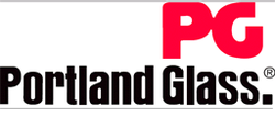


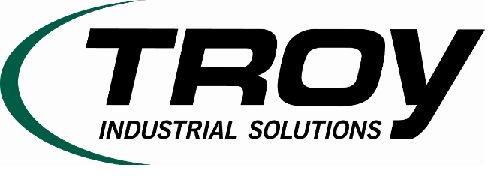
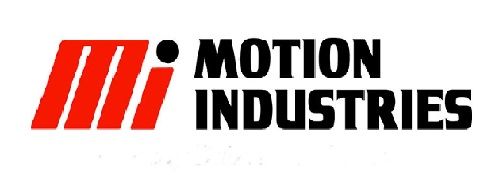
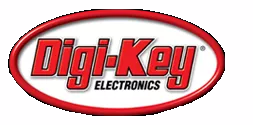


Supplies Unlimited & Oliver’s Print Shop


John’s Marine Care




